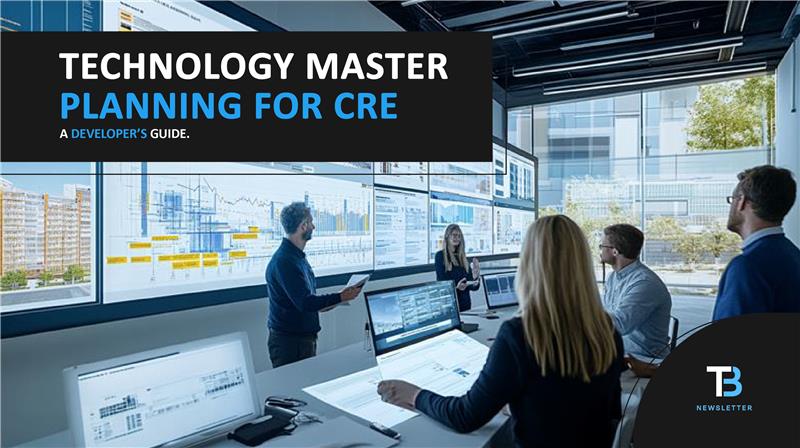
Published by Layer 10 | Insights on the Built Environment, Technology, and Innovation
Smart Buildings Start Long Before Construction
In commercial real estate, technology is often one of the last decisions made—but ironically, it’s the one that can have the longest-lasting impact on a building’s success.
When technology is treated as a bolt-on feature, it creates a cascade of problems:
- Costly rework and retrofits
- Disconnected systems and user frustration
- Delays in project timelines and diminished returns
This is where Technology Master Planning (TMP) comes in. It’s the blueprint that connects your design vision with real-world execution, ensuring every system—digital, physical, or human—works in harmony from day one.
In this post, we’ll break down:
✅ What a technology master plan is
✅ Why developers can’t afford to skip it
✅ The five essential components of a great plan
✅ Common mistakes to avoid
✅ How to get started
What Is a Technology Master Plan?
A Technology Master Plan is a strategic roadmap that defines how technology will be:
- Selected
- Integrated
- Managed
- Scaled
… over the full lifecycle of a real estate project.
More than just a tech spec sheet, your TMP:
- Aligns with business objectives
- Accounts for user experience and operational needs
- Evolves with emerging technology and tenant expectations
- Guides decision-making from pre-design through post-occupancy
Think of it as the glue between your design intent and digital infrastructure.
“Technology is not just a feature of your building—it’s part of its foundation. A solid plan makes everything else stronger.”
— Ken Wilkinson, CEO, Layer 10
Why You Need a Technology Master Plan—Now
Many projects don’t fail because of bad technology. They fail because of:
- Misalignment across teams
- Last-minute decisions
- Vendor-driven solutions that don’t serve the business
A TMP prevents this by ensuring technology is purposefully designed, budgeted, and phased—not tacked on.
The Value of Master Planning Includes:
✅ Better cost control and value engineering
✅ Faster project delivery and fewer RFIs
✅ Future-ready infrastructure that scales
✅ Higher tenant satisfaction and retention
The 5 Core Components of a Smart Technology Master Plan
1️⃣ Vision Alignment
Every successful TMP starts with one question:
“What is this building supposed to do?”
Is it a Class A office space focused on tenant amenities?
A mixed-use development centered on digital access and community integration?
An energy-efficient building pursuing LEED or ESG targets?
Technology should support those goals—not dictate them.
2️⃣ Stakeholder Collaboration
You can’t build a smart building in a silo.
Your TMP should reflect input from:
- Developers
- Architects and MEP engineers
- General contractors
- Property managers
- IT teams and consultants
- Marketing and leasing
Bringing these voices together early helps ensure the technology plan works across disciplines and departments.
3️⃣ Infrastructure Readiness
Without the right foundation, even the best technology fails.
Your plan should address:
- Conduit pathways and risers
- Network topology and bandwidth
- IDF/MDF locations
- Power, cooling, and space requirements
Build flexibility in now, so you’re not cutting drywall later.
4️⃣ Phased Implementation Strategy
Not all systems need to be installed upfront. But they should be accounted for in the master plan.
Break your strategy into:
- Core systems (WiFi, access control, security)
- Next-phase systems (AI-based energy optimization, digital signage)
- Optional enhancements (touchless amenities, digital twin platforms)
A phased roadmap allows you to deploy tech as budgets and needs evolve—without reworking the design.
5️⃣ Governance & Adaptability
Your building’s technology shouldn’t be static. Your TMP should define:
- Ownership and responsibilities
- Maintenance and update protocols
- Integration standards
- Change management plans
When systems evolve, you want guidelines in place—not chaos.
Common Pitfalls to Avoid
Despite best intentions, many CRE teams fall into familiar traps when it comes to technology planning. Here’s what to avoid:
❌ Engaging tech consultants too late – If it’s post-construction, it’s often too late to influence meaningful integration.
❌ Letting vendors drive the roadmap – Product pitches aren’t strategies. You need an independent perspective.
❌ Over-engineering with features tenants won’t use – User-centered design always wins.
❌ Ignoring future flexibility – Systems that don’t scale will cost more later.
How to Get Started
Starting a Technology Master Plan doesn’t require perfect clarity. It requires strategic intent.
Here’s how to begin:
- Clarify your building’s purpose and long-term value goals
- Engage a technology strategist early in the design phase
- Convene stakeholders to align on user needs and business drivers
- Identify core systems and infrastructure requirements
- Build a roadmap with phased deliverables, budget alignment, and flexibility
🎓 Learn to Build Smarter at Layer 10 Academy
At Layer 10 Academy, we teach CRE professionals how to:
✅ Align technology strategy with design and business objectives
✅ Avoid common planning mistakes that drive up costs
✅ Build systems that scale, adapt, and integrate over time
Whether you’re new to smart building planning or looking to improve your current strategy, we offer the tools, frameworks, and real-world insights you need to succeed.
🔗 → Start designing future-ready buildings today: Explore Layer 10 Academy
Final Thoughts: Planning Isn’t Optional—It’s Your Edge
Smart buildings don’t begin with hardware—they begin with strategy.
Technology Master Planning isn’t about making all the right decisions up front. It’s about creating a process that allows your team to make the right decisions at the right time, with clarity and purpose.
And in today’s market, that’s not just smart—it’s essential.
Let’s build tomorrow, today.
📌 Related Articles
• The Cost of Doing Nothing: Why Inaction Is the Most Expensive CRE Mistake
• Engaging Tenants Through Smart Technology: Meeting Modern Expectations
• Transforming CRE: Maximizing Returns with Smart PropTech Investments